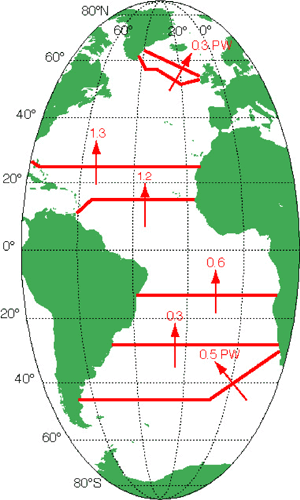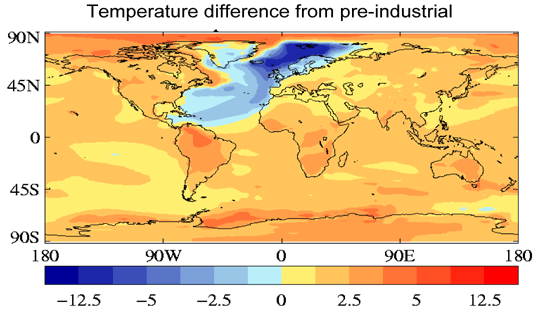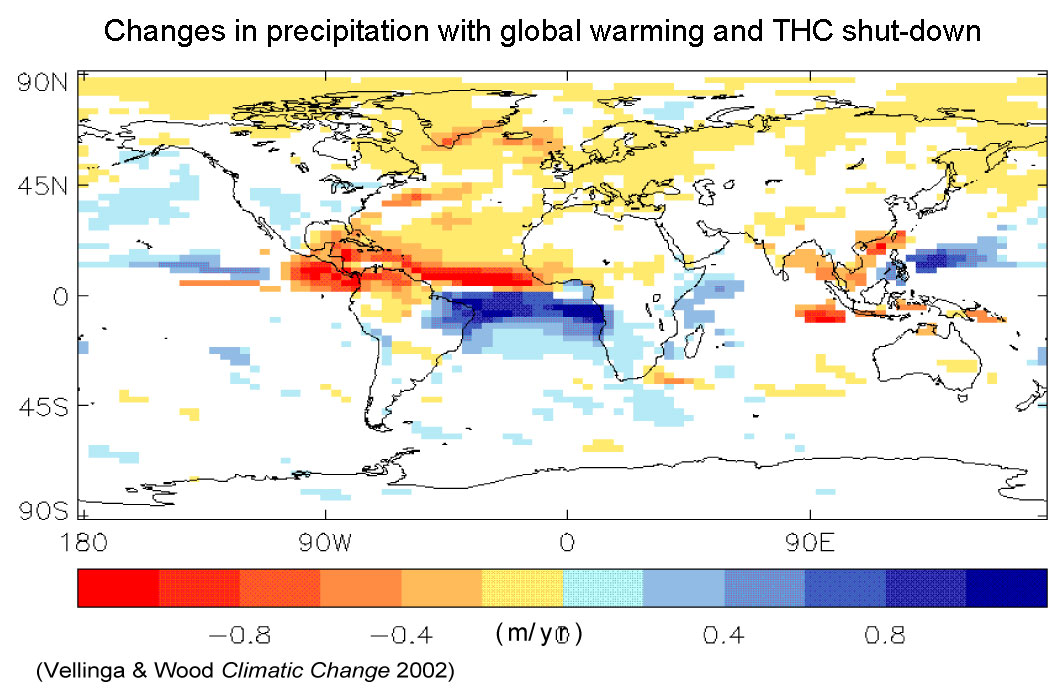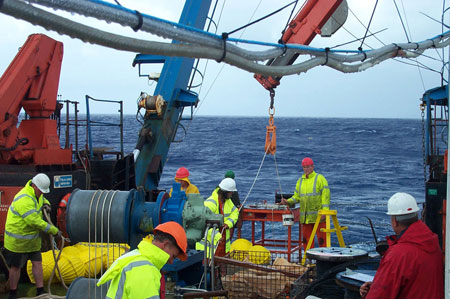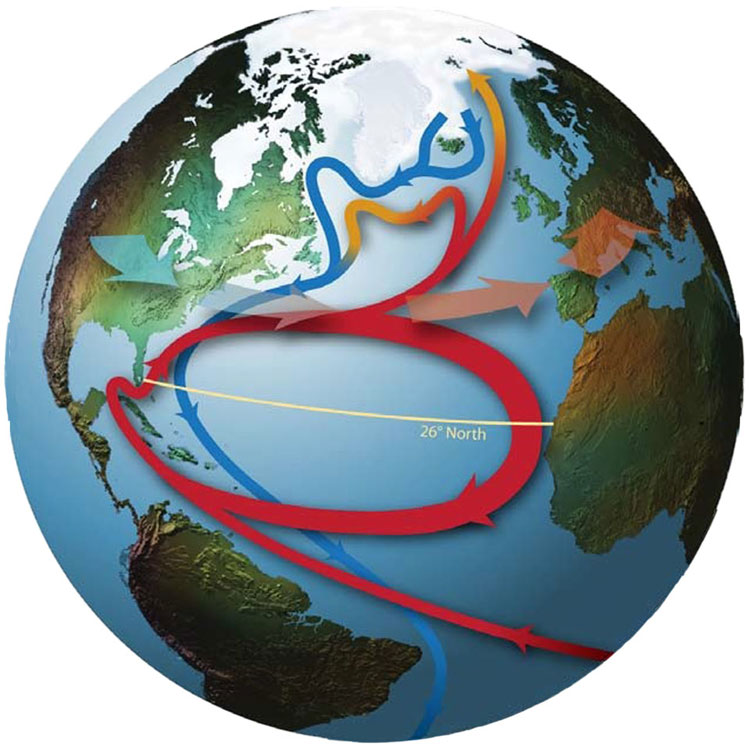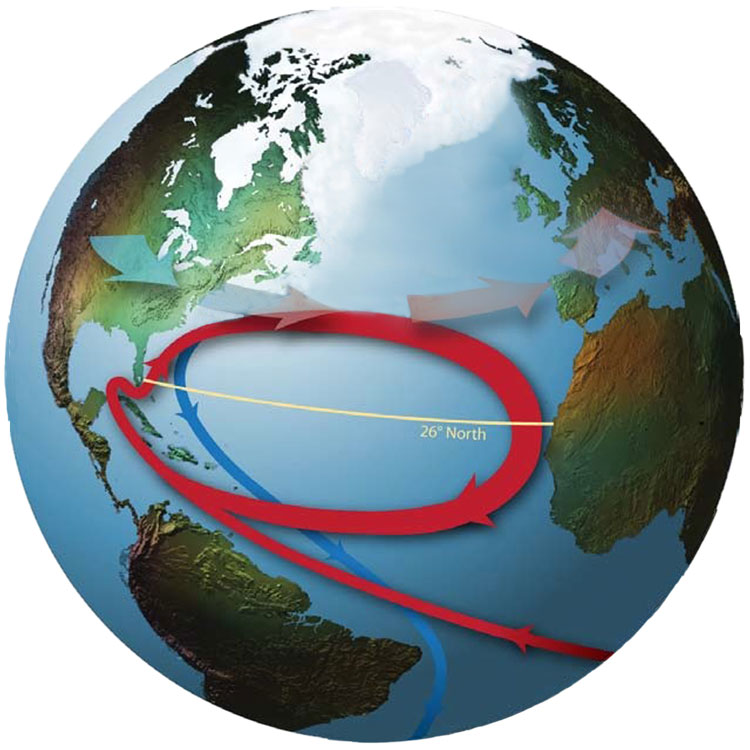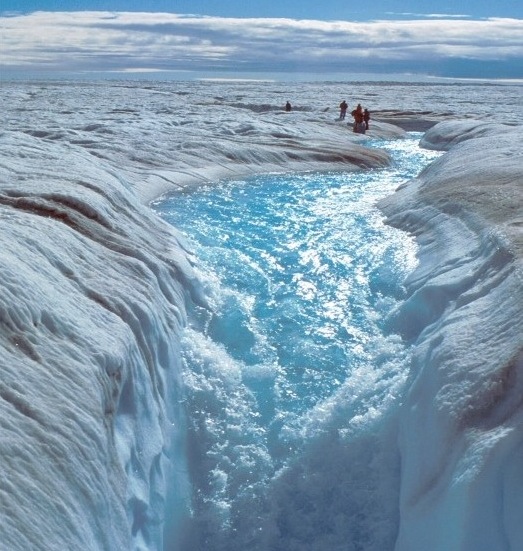3. The Conveyor and Global Warming (2/2)
Will rising temperatures slow the conveyor?
Most of the climate models in the 4th IPCC report showed that the conveyor will slow down as global temperatures increases. To understand why, we need to look at the special role of the Atlantic Ocean.
Why the Atlantic is special
The Atlantic is the only ocean where heat is transported north across the equator. Here warm salty water from the tropics reaches further north than in any other ocean. As it cools and sinks it drives the Northern Hemisphere loop of the global conveyor.
In the Pacific there is no such area where salty subtropical water can travel far enough north and cool down sufficiently to sink. If the North Atlantic deep water formation slows down or stops, this will slow down the entire global conveyor.
Why would the sinking decrease?
There are two potential causes of reduced deep-water formation in the North Atlantic:
- increased melting of the Greenland ice sheet, and
- increased rainfall at mid- to high latitudes.
Quick Questions
- Why would this make a difference to the formation of deep water in the North Atlantic?
- What effect would this have on climate in northwest Europe?
Effects of a shut-down
To understand how a slowdown of the conveyor may change regional climate patterns, climate scientists have carried out a number of computer experiments in which they shut down the THC by releasing huge quantities of fresh water into the North Atlantic. One such experiment was carried out with HadCM 3, the climate model of the UK Met-Office.
Quick questions
- In the map of surface air temperature - how does the North Atlantic compare with the rest of the world?
- Which regions see the strongest warming as a result of this experiment?
- In the map of global precipitation, which regions will see a reduction in rainfall, and which will see an increase?
- How is this likely to affect primary production (plant growth) in different regions?
Measuring the Atlantic overturning at 26° North
Because of the consequences of a slow-down could be severe, we want to know if it has begun. To find out scientists have deployed (put out) an array of instruments across the Atlantic at 26°N.
The array continuously measures the overturning - the flow northwards at the surface, and southwards at depth. The measurements started in 2004, but it is still too early to tell if the overturning is changing.
Possible changes to the Atlantic circulation
Most of the warm tropical water from the Gulf Stream returns south at the surface as part of the subtropical gyre, but a branch flows northwestwards towards higher latitude (above left). If deep water formation in the Nordic Seas were to stop, most of this water would return south (above right).
Melting of Greenland ice
Melting of the Greenland ice sheet will add fresh water to the North Atlantic.
If this happens fast, it could make the conveyor slow down. Climate models today may be using a melt rate that is too low.
When melt water flows into a moulin (a crack that leads to the bottom of the ice sheet), this can make the ice slide faster towards the sea. This will increase the melt rate as the glacier 'calves' more icebergs into the ocean.
Sea ice is a barrier to the calving and southward transport of ice bergs. As summer sea ice disappears, this barrier will be removed, and the loss of ice from the Greenland ice sheet will speed up.
How likely is a shut-down?
The model experiments shown on the left were made with HADCM3 by flooding the Atlantic with unrealistic amounts of fresh water. They are not predictions of the future. What they show is how of a complete shut-down of the conveyor could affect global patterns of temperature and rainfall. Computer experiments like this can give us useful insights in how a reduction in the conveyor may affect climate around the world.
More realistic computer experiments with this and other climate models do not show a complete shut-down. Instead we see a gradual slow-down of the Atlantic conveyor as global temperatures increase. However, these models do not yet represent the melting of Greenland ice in full detail.
At present most climate scientists agree that a shut-down of the THC is unlikely. The conveyor is more likely to slow down. How much and how fast may depend on the extent of global warming.
The global conveyor: summary
- The global conveyor has earnt its nick-name because it brings heat from the tropics to high latitudes.
- The conveyor is driven by sinking of cold, dense water in the Labrador and Nordic Seas.
- Water returns to the surface in the Southern Ocean and through mixing and upwelling at lower latitudes.
- Global warming could lead to the North Atlantic becoming fresher. If so, the conveyor may slow down.
